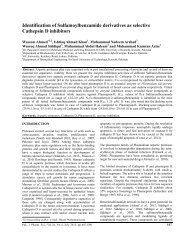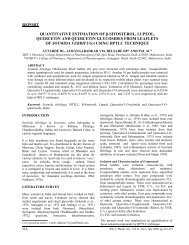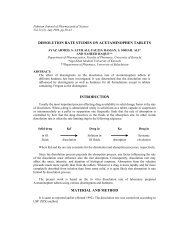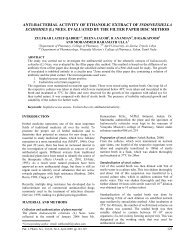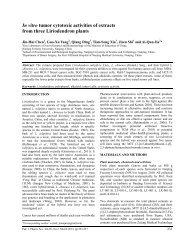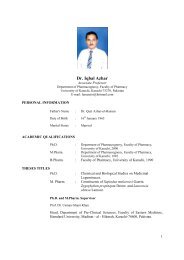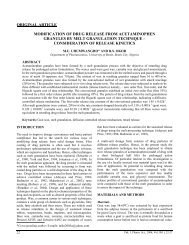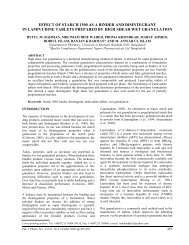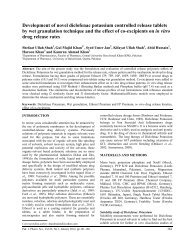Lamivudine-artesunate co-administration affects glucose ...
Lamivudine-artesunate co-administration affects glucose ...
Lamivudine-artesunate co-administration affects glucose ...
You also want an ePaper? Increase the reach of your titles
YUMPU automatically turns print PDFs into web optimized ePapers that Google loves.
<strong>Lamivudine</strong>-<strong>artesunate</strong> <strong>co</strong>-<strong>administration</strong> <strong>affects</strong> glu<strong>co</strong>se metabolism<br />
in healthy and diseased wistar rats<br />
Temidayo Olurishe* 1 , Helen Kwanashie 1 , Joseph Anuka 1 and Haruna Muktar 2<br />
1 Department of Pharma<strong>co</strong>logy & Therapeutics Ahmadu Bello University, PMB 1045, Zaria, Nigeria<br />
2 Department of Haematology and Blood Transfusion, Ahmadu Bello University Teaching Hospital, PMB 06, Zaria, Nigeria<br />
Abstract: HIV-Malaria <strong>co</strong> morbidity frequently requires the <strong>co</strong> <strong>administration</strong> of <strong>Lamivudine</strong> and Artesunate, in Malaria<br />
endemic areas where HIV is also a problem. This situation is a frequent occurrence in developing <strong>co</strong>untries of the<br />
tropics, like Nigeria where the burden of Malaria and HIV is heavy. The <strong>co</strong> <strong>administration</strong> of these drugs may result in<br />
interactions with possible physiologic and/or therapeutic <strong>co</strong>nsequences. This study investigated the effect of<br />
<strong>Lamivudine</strong>-Artesunate <strong>co</strong> <strong>administration</strong> on body weight, relative organ weight and glu<strong>co</strong>se tolerance in healthy and<br />
diseased (Plasmodium berghei infected and cyclophosphamide immunosuppressed) wistar rats. Animals received a<br />
cumulative 21 day treatment with <strong>Lamivudine</strong> (20 mg/kg) and/or 7 day Artesunate (10 mg/kg), with healthy or disease<br />
<strong>co</strong>ntrols. Results showed that organ weights and body weights were not affected. Oral glu<strong>co</strong>se was however affected in<br />
the <strong>co</strong>mbination and Artesunate groups in both disease and healthy rats. The study shows that glu<strong>co</strong>se tolerance is altered<br />
with <strong>Lamivudine</strong>-Artesunate <strong>co</strong> <strong>administration</strong>, and may be beneficial, as hypoglycaemia is often a <strong>co</strong>mplication of<br />
Malaria therapy.<br />
Keywords: Drug interaction, glu<strong>co</strong>se tolerance, <strong>artesunate</strong>, lamivudine.<br />
INTRODUCTION<br />
Malaria and HIV are amongst the three biggest diseases<br />
of global importance alongside Tuberculosis, killing<br />
millions of people yearly (Hotez et al., 2006), and also<br />
undermining development in resource poor <strong>co</strong>untries. In<br />
sub-Saharan Africa, the overlap between Malaria and HIV<br />
has made an even greater health impact <strong>co</strong>mplicated by<br />
inadequate health facilities, poverty and ignorance which<br />
is very often associated with stigmatization in HIV. Data<br />
has also shown that viral RNA for HIV1 is increased in<br />
Malaria (Hoffman et al., 1999). For life expectancy to be<br />
improved, the need for effective therapy in the <strong>co</strong> morbid<br />
state of Malaria and HIV is essential. With Malaria being<br />
an opportunistic infection in HIV, the occurrence of HIV-<br />
Malaria <strong>co</strong> morbid state increases the Malaria burden in<br />
Malaria endemic regions. <strong>Lamivudine</strong> is frequently used<br />
as a <strong>co</strong>mponent of highly active anti-retroviral therapy<br />
(HAART) globally (John et al., 2008). It is also used as a<br />
sole therapeutic agent in treatment of hepatitis B virus<br />
infection (Zhang, et al., 2000) in the tropics including in<br />
Nigeria. Artesunate is the most widely used artemisinin<br />
derivative (Zhang et al., 2001) and forms the backbone of<br />
many of the available artemisinin based <strong>co</strong>mbination<br />
therapies in falciparum Malaria. Artemisinin derivatives<br />
have a very rapid onset of action, resulting in rapid<br />
parasite clearance and also being effective against<br />
parasites that are resistant to other anti-Malarial drugs<br />
(Schwarz et al., 2005), and is used in both un<strong>co</strong>mplicated<br />
and severe Malaria. Both <strong>Lamivudine</strong> and Artesunate<br />
often find use in non disease states when used either for<br />
*Corresponding author: e-mail: olurishe@hotmail.<strong>co</strong>m<br />
post exposure prophylaxis, in the case of <strong>Lamivudine</strong>, or<br />
presumptive treatment in Malaria with Artesunate. This<br />
<strong>co</strong>ncurrent <strong>administration</strong> of <strong>Lamivudine</strong> and Artesunate<br />
presents possibilities for interactions that may affect<br />
various biochemical parameters and physiological<br />
functions, in addition to those that may be results of<br />
plasmodiasis and/or immunosuppression. The current<br />
study investigated the possible effect(s) of <strong>Lamivudine</strong>-<br />
Artesunate <strong>co</strong> <strong>administration</strong> on glu<strong>co</strong>se tolerance, body<br />
and relative weights of the pancreas in healthy and<br />
diseased adult wistar rats.<br />
MATERIALS AND METHODS<br />
Animals<br />
Wistar rats of either sex in-bred in the Animal House of<br />
the Department of Pharma<strong>co</strong>logy and Therapeutics,<br />
Ahmadu Bello University Zaria, Nigeria, weighing 180-<br />
245 g were used in this study. The animals were fed on<br />
Vital Feed (Bukuru, Jos-Nigeria) and water (from public<br />
supply) ad libitum except when oral glu<strong>co</strong>se tolerance test<br />
was <strong>co</strong>nducted. Animals were used in ac<strong>co</strong>rdance with the<br />
NIH guideline for use of animals and were also approved<br />
by the Department.<br />
Healthy animals<br />
To investigate the effect of 3TC-AS <strong>co</strong> <strong>administration</strong> in<br />
apparently healthy animals, four groups of rats were used,<br />
with each group having five animals. Group I served as<br />
<strong>co</strong>ntrol. Group II received 3TC (20 mg/kg) for 21 days. In<br />
addition to 3TC, group III received AS 10 mg/kg from<br />
day 15-21. Group IV received only AS (10 mg/kg) from<br />
day 15-21.<br />
Pak. J. Pharm. Sci., Vol.25, No.3, July 2012, pp.543-547 543
<strong>Lamivudine</strong>-<strong>artesunate</strong> <strong>co</strong>-<strong>administration</strong> <strong>affects</strong> glu<strong>co</strong>se metabolism<br />
Disease-state animals<br />
Disease state animals were animals that were<br />
immunosuppressed with cyclophosphamide, while<br />
simultaneously infected with Plasmodium berghei species<br />
of Malaria parasite obtained from the National Institute<br />
for Pharmaceutical Research and Development, Abuja-<br />
Nigeria.<br />
Immunosuppression and plasmodium infection<br />
Immunosuppression was induced using cyclophosphamide,<br />
with an intraperitoneal stat dose of 100 mg/kg on<br />
day 1 (Huang et al., 2005), with a booster 50 mg/kg on<br />
day 8. Plasmodium berghei infection was achieved by<br />
intraperitoneal injection of a 0.2 ml inoculum <strong>co</strong>ntaining<br />
about 1x10 7 parasites (Okokon et al., 2006) seventy-two<br />
hours before the <strong>co</strong>mmencement of AS <strong>administration</strong> for<br />
groups that received AS. Animals for this study were<br />
grouped into 5 with group I serving as healthy <strong>co</strong>ntrols.<br />
All other groups were infected with Plasmodium berghei<br />
and received immunosuppressive treatment with<br />
cyclophosphamide. Animals in the remaining four groups<br />
(n=5) were treated as follows; the se<strong>co</strong>nd group served as<br />
diseased <strong>co</strong>ntrol. The third and fourth groups received<br />
<strong>Lamivudine</strong> (Evans) 20 mg/kg (dissolved in distilled<br />
water) from days 1-14. The fifth group received<br />
Artesunate (Tuyil) 10 mg/kg (dissolved in saline with<br />
sodium bicarbonate aided dissolution, from day 15 to 21,<br />
while the third group added Artesunate from day 15 to 21,<br />
the drugs being all administered intraperitoneally.<br />
In both healthy and diseased animals, the weights of the<br />
animals were re<strong>co</strong>rded weekly. On the 20 th day, the<br />
animals were subjected to overnight fast (18 hours) after<br />
which they were subjected to the oral glu<strong>co</strong>se tolerance<br />
test by receiving 2 g/kg oral glu<strong>co</strong>se (Evans) in solution<br />
following the method previously described (Saravanan<br />
and Pari, 2008). Glu<strong>co</strong>se levels were determined by<br />
snipping the terminal 3 mm of the rats’ tails, using<br />
glu<strong>co</strong>se oxidase method, with the aid of a digital<br />
glu<strong>co</strong>meter with <strong>co</strong>mpatible strips (On-call-Now, USA) at<br />
times 0, 30, 60 and 120 minutes. On the 21 st day, the<br />
animals were sacrificed following light chloroform<br />
anaesthesia and the animals were dissected and their<br />
pancreas removed, weighed using a Denver Balance and<br />
the relative pancreas weights were calculated.<br />
STATISTICAL ANALYSIS<br />
Data obtained from the study are presented as mean ±<br />
SEM and analysed using One Way ANOVA followed by<br />
Dunnett’s pos hoc test. P values less than 0.05 were<br />
<strong>co</strong>nsidered statistically significant.<br />
RESULTS<br />
Following the 21 day treatment including one week of <strong>co</strong><strong>administration</strong><br />
of <strong>Lamivudine</strong> and Artesunate, there was<br />
544<br />
no statistically significant variation in the oral glu<strong>co</strong>se<br />
tolerance test result for all the groups in the healthy<br />
animal model when <strong>co</strong>mpared with vehicle <strong>co</strong>ntrol.<br />
However, there was a slight alteration in glu<strong>co</strong>se<br />
tolerance observed in rats that received Artesunate (table<br />
1). Body weight was also not significantly altered<br />
<strong>co</strong>mparing the <strong>co</strong>ntrols with the test through the 21 day<br />
study period (table 2). Oral glu<strong>co</strong>se tolerance was also not<br />
significantly altered in rats that were immunosuppressed<br />
with cyclophosphamide while also simultaneously<br />
infected with Plasmodium berghei (table 3), with groups<br />
that received Artesunate however showing elevated<br />
glu<strong>co</strong>se levels in the OGGT. Table 4 shows that in the<br />
diseased model, there were statistically significant<br />
differences in body weights, particularly observed with<br />
animals that received only <strong>Lamivudine</strong> or vehicle with<br />
immunosuppression (p
worthy note as the <strong>co</strong>nsequence of this in frank diabetes<br />
may be more significant. Considering the long period of<br />
use of <strong>Lamivudine</strong> and intermittent Malaria therapy, the<br />
already known possible effects of <strong>Lamivudine</strong><br />
involvement in pancreatitis, there may be unpredictable<br />
manifestations on glu<strong>co</strong>se tolerance, prediabetes and<br />
diabetes.<br />
The <strong>co</strong>mbination of 3TC-AS did not have any significant<br />
effect on body weight in the healthy animals (table 2).<br />
This was however not the case in the diseased animals<br />
(table 4) where there was significant weight reduction<br />
between all immunosuppressed and parasitized group<br />
when <strong>co</strong>mpared with the group that relieved only the<br />
vehicle. However weight loss was not as much in the<br />
group that received Artesunate alone or Artesunate and<br />
<strong>Lamivudine</strong>. When <strong>co</strong>mpared with the immunosuppressed<br />
Temidayo Olurishe et al.<br />
Table 1: Effect of lamivudine-<strong>artesunate</strong> <strong>co</strong>-<strong>administration</strong> on oral glu<strong>co</strong>se tolerance test in healthy wistar rats<br />
Treatment Group<br />
0 Minutes<br />
Mean glu<strong>co</strong>se <strong>co</strong>ncentration (mmoles/litre)<br />
30 Minutes 60 Minutes 120 Minutes<br />
VEH 3.60 ± 0.26 5.25 ± 0.42 5.32 ± 0.13 4.60 ± 0.27<br />
3TC 3.72 ± 0.02 5.34 ± 0.26 5.20 ± 0.17 4.96 ± 0.39<br />
3TC+AS 4.10 ± 0.28 5.50 ± 0. 42 6.36 ± 0.60 5.42 ± 0.57<br />
AS 4.00 ± 0.15 5.90 ± 0.45 5.86 ± 0.18 5.04 ± 0.51<br />
VEH=vehicle; 3TC=<strong>Lamivudine</strong>; 3TC+AS=<strong>Lamivudine</strong>+ Artesunate; AS=Artesunate.<br />
Data shown in the table are means ± SEM, (n=5). There were no statistically significant differences when data were subjected to<br />
ANOVA followed by Dunnett’s post hoc test.<br />
Table 2: Effect of lamivudine-<strong>artesunate</strong> <strong>co</strong>-<strong>administration</strong> on body weight in healthy wistar rats<br />
Treatment Group<br />
Day 0<br />
Mean weight of animals in grams<br />
Day 15 Day 21<br />
VEH 228.4 ± 11.84 242.2 ± 11.5 231.2 ± 11.7<br />
3TC 221.0 ± 10.11 229.8 ± 8.8 238.2 ± 8.7<br />
3TC+AS 223.4 ± 8.17 225.0 ± 4.27 237.6 ± 6.9<br />
AS 228.6 ± 7.36 243.0 ± 6.7 237.6 ± 8.7<br />
VEH=vehicle; 3TC=<strong>Lamivudine</strong>; 3TC+AS=<strong>Lamivudine</strong>+ Artesunate; AS=Artesunate.<br />
Data shown in the table are means ± SEM, (n=5). There were no statistically significant differences when data were subjected to<br />
ANOVA followed by Dunnett’s post hoc test.<br />
Table 3: Effect of lamivudine-<strong>artesunate</strong> <strong>co</strong>-<strong>administration</strong> on oral glu<strong>co</strong>se tolerance test in cyclophosphamideimmunosuppresed<br />
and P. berghei infected wistar rats<br />
Treatment Group<br />
0 Minutes<br />
Mean glu<strong>co</strong>se <strong>co</strong>ncentration (mmoles/litre)<br />
30 Minutes 60 Minutes 120 Minutes<br />
VEH 2.26 ± 0.20 3.32 ± 0.43 4.36 ± 0.38 2.94 ± 0.16<br />
VIP 3.00 ± 0.40 3.65 ± 0.75 3.05 ± 0.75 2.85 ± 0.05<br />
LIP 2.55 ± 0.65 3.90 ± 1.80 3.50 ± 1.70 2.80 ± 1.00<br />
LAIP 2.76 ± 0.42 3.86 ± 0.36 5.40 ± 0.47 3.66 ± 0.13<br />
AIP 2.96 ± 0.13 3.90 ± 0.40 4.63 ± 0.28 3.73 ±0. 08<br />
VEH=vehicle treatment alone, VIP=vehicle treatment with immunosuppression and parasitaemia, LIP=<strong>Lamivudine</strong> with<br />
immunosuppression and parasitaemia, LAIP=<strong>Lamivudine</strong>+Artesunate with immunuosuppression and parasitaemia, AIP=Artesunate<br />
with immunosuppression and parasitaemia; 3TC=<strong>Lamivudine</strong>; AS=Artesunate<br />
Data shown in the table are means ± SEM, (n=5). There were no statistically significant differences when data were subjected to<br />
ANOVA followed by Dunnett’s post hoc test.<br />
and parasitized vehicle group alone, weight variations<br />
were numerically different but not of statistical<br />
significance. This shows that the observed weight<br />
difference was due only to immunosuppression and<br />
parasitaemia. Weight loss is usually associated with HIV<br />
wasting syndrome. It has also been reported that in non<br />
HIV CD4 + lymphocytopenia significant weight loss is<br />
observed (Kaczmarski et al., 1994), and may therefore be<br />
attributed to the effects of immunosuppression. This thus<br />
supports the observed weight loss <strong>co</strong>nsequent on<br />
immunosuppression and also shows the importance of<br />
<strong>co</strong>mpliance with therapy in these disease <strong>co</strong>nditions.<br />
In both healthy and diseased animals, there were no<br />
significant differences in the relative weights of the<br />
pancreas (table 5). Thus it may be possible that the<br />
alteration in glu<strong>co</strong>se metabolism owing to the <strong>co</strong><br />
Pak. J. Pharm. Sci., Vol.25, No.3, July 2012, pp.543-547 545
<strong>Lamivudine</strong>-<strong>artesunate</strong> <strong>co</strong>-<strong>administration</strong> <strong>affects</strong> glu<strong>co</strong>se metabolism<br />
Table 4: Effect of lamivudine-<strong>artesunate</strong> <strong>co</strong>-<strong>administration</strong> on body weight in CYC and mp treated wistar rats<br />
Treatment Group<br />
Day 1<br />
Mean Weight of Animals in grams<br />
Day 15 Day 21<br />
VEH 177.8 ± 8.046 217.2± 7.519 217.2 ± 7.519<br />
VIP 177.6 ± 8.177 148.3± 10.68** 148.3 ± 10.68*<br />
LIP 176.2 ± 8.387 162.8± 6.047** 162.8 ± 6.047*<br />
LAIP 177.0 ± 8.204 172.2± 13.62* 172.2 ± 13.62*<br />
AIP 177.2 ± 8.206 183.5 ± 9.811 183.5 ± 9.811*<br />
VEH=vehicle treatment alone, VIP=vehicle treatment with immunosuppression and parasitaemia, LIP=<strong>Lamivudine</strong> with<br />
immunosuppression and parasitaemia, LAIP=<strong>Lamivudine</strong>+Artesunate with immunuosuppression and parasitaemia, AIP=Artesunate<br />
with immunosuppression and parasitaemia; 3TC=<strong>Lamivudine</strong>; AS=Artesunate<br />
Data shown in the table are means ± SEM, (n=5). *=p0.05 2 VIP 0.21 ± 0.08 p >0.05<br />
3 3TC+AS 0.29±0.02 p >0.05 3 LIP 0.21 ± 0.01 p >0.05<br />
4 AS 0.29±0.01 p >0.05 4 LIAP 0.21 ± 0.03 p >0.05<br />
5 AS 0.17 ± 0.02 p >0.05<br />
VEH=Vehicle; 3TC=<strong>Lamivudine</strong>; AS=Artesunate; VIP=Vehicle treatment with immunosuppression and parasitaemia,<br />
LIP=<strong>Lamivudine</strong> with immunosuppression and parasitaemia, LAIP=<strong>Lamivudine</strong>+Artesunate with immunuosuppression and<br />
parasitaemia, AIP=Artesunate with immunosuppression and parasitaemia; 3TC=<strong>Lamivudine</strong>. Data shown in the table are means ±<br />
SEM, (n=5). There were no statistically significant differences when data were subjected to ANOVA followed by Dunnett’s post<br />
hoc test.<br />
<strong>administration</strong> of <strong>Lamivudine</strong> and Artesunate may not<br />
necessarily be <strong>co</strong>nsequent upon significant damage of the<br />
pancreas.<br />
CONCLUSION<br />
The current study has shown that glu<strong>co</strong>se tolerance is<br />
affected by the <strong>co</strong> <strong>administration</strong> of <strong>Lamivudine</strong> and<br />
Artesunate in healthy rats as well as in parasitized and<br />
immunosuppressed rats. Relative weights of the pancreas<br />
were however unchanged and body weight in diseased<br />
rats were not altered significantly when diseased <strong>co</strong>ntrols<br />
and treated animals were <strong>co</strong>mpared. Although these<br />
alterations were not statistically significant, this may<br />
signal a need for glu<strong>co</strong>se monitoring with the <strong>co</strong>ncurrent<br />
use of both drugs. The impairment in glu<strong>co</strong>se tolerance<br />
may also need to be followed for longer time for<br />
possibility of development of frank diabetes. The possible<br />
<strong>co</strong>nsequence of this interaction in clinical situations<br />
should be studied in order to make necessary therapeutic<br />
modifications if need be.<br />
REFERENCES<br />
Davis TME (1997). Antimalarial drugs and glu<strong>co</strong>se<br />
metabolism. Br. J. Clin. Pharma<strong>co</strong>l., 44: 1-7.<br />
546<br />
Hoffman IF, Jere CS, Taylor TE, Munthali P, Dyer JR,<br />
Wirima JJ, Rogerson SJ, Kumwenda, N, Eron, JJ,<br />
Fiscus SA, Chakraborty H, Taha TE, Cohen MS and<br />
Molyneux ME (1999). The effect of Plasmodium<br />
falciparum malaria on HIV-1 RNA blood plasma<br />
<strong>co</strong>ncentration. AIDS, 13: 487-494.<br />
Hotez PJ, Molyneux DH, Fenwick A, Ottesen E, Sachs<br />
ES and Sachs JD (2006). In<strong>co</strong>rporating a rapid-impact<br />
package for neglected tropical diseases with programs<br />
for HIV/AIDS, tuberculosis, and malaria. PLoS<br />
Medicine, 3: e102.doi:10.1371/journal.pmed. 0030102.<br />
Huang FJ, Lu ZB, Li, Q, Wei LJ, Zhang L and Wu WT<br />
(2005). Study on hepatoprotective effect of peptide s-<br />
8300 from shark liver. World J. Gastroenterol., 11:<br />
1809-1812.<br />
John MA, Yasin A, Rhemtula YA, Menezes CN and<br />
Grobusch MP (2008). <strong>Lamivudine</strong>-induced red cell<br />
Aplasia. Journal Med. Microbiol., 57: 032-1035.<br />
Kaczmarski RS, Webster ADB, Moxham J, Davison F,<br />
Sutherland S and Mufti GJ (1994). CD4 +<br />
lymphocytopenia due to <strong>co</strong>mmon variable<br />
immunodeficiency mimicking AIDS. J. Clin. Pathol.,<br />
47: 364-366.<br />
La Fluer SE, Kalsbeek A, Wortel J, Fekkes ML and Buijs<br />
RM (2001). A daily rhythm in glu<strong>co</strong>se tolerance a Role<br />
for the Suprachiasmatic Nucleus. Diabetes., 50: 1237-<br />
1243.<br />
Pak. J. Pharm. Sci., Vol.25, No.3, July 2012, pp.543-547
Okokon JE, Udokpoh AE and Essiet GA (2006). Antimalarial<br />
activity of Mammea africana. Afr. J. Tradit.<br />
Complement Altern. Med., 3(4):43-49.<br />
Saravanan G and Pari L (2008). Hypoglycemic and anti-<br />
hyperglycemic effect of Syzgium cumini bark on<br />
streptozotocin-induced diabetic rats. J. Pharma<strong>co</strong>l.<br />
Toxi<strong>co</strong>l., 3(1): 1-10.<br />
Schwarz NG, Oyakhirome S, Pötschke M, Gläser B,<br />
Klouwenberg PK, Altun H, Adegnika AA, Issifou S,<br />
Jürgen FJ, Kun JFJ, Kremsner PG and Grobusch MP<br />
(2005). 5-days non-observed <strong>artesunate</strong> monotherapy<br />
for treating un<strong>co</strong>mplicated falciparum malaria in young<br />
gabonese children. Am. J. Trop. Med. Hyg., 73: 705-<br />
709.<br />
Temidayo Olurishe et al.<br />
Wiegand S, Maikowski U, Blankenstein O, Biebermann<br />
H, Tarnow P and Gruters A (2004). Type 2 diabetes<br />
and impaired glu<strong>co</strong>se tolerance in european children<br />
and adolescents with obesity – a problem that is no<br />
longer restricted to minority groups. Euro. J.<br />
Endocrinol., 151: 199-206.<br />
Wiener K and Roberts NB (1998). Diagnostic criteria for<br />
diabetes mellitus. Clin Chem., 44: 2222-2224.<br />
Zhang X, Han Y, Lu Z, Zhang D and Cai Y (2000).<br />
Detection of hepatitis B virus polymerase variation<br />
resistance to lamivudine therapy. Chinese Chin. Med.<br />
J., 113: 455-457.<br />
Zhang SQ, Hai TN, Ilett KF, Huong DX, Davis TME and<br />
Ashton M (2001). Multiple dose study of interactions<br />
between <strong>artesunate</strong> and artemisinin in healthy<br />
volunteers. Br. J. Clin. Pharma<strong>co</strong>l., 52: 377-385.<br />
Pak. J. Pharm. Sci., Vol.25, No.3, July 2012, pp.543-547 547



